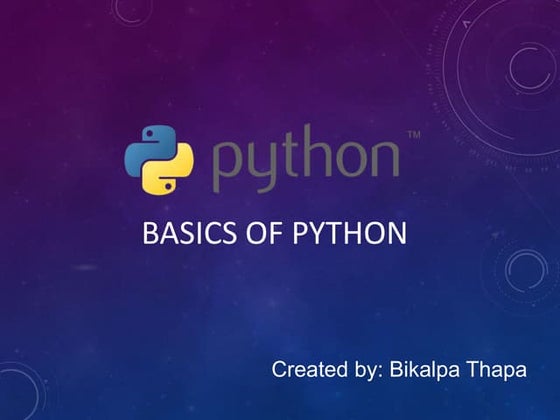Qbasic introduction
- 1. QBasic andQBasic and ProgrammingProgramming PresentationPresentation Prepared by: Obusan, Janssen Roselle T. Opiana, Christian Joseph I.
- 2. QBasic It all started back in 1963 when John Goerge Kemeny and Tom Kurtzas got together at Dartmouth College. It is an interpreter which reads every line, translates it and lets the computer execute it. NOTE: BASIC stands for Beginnerâs All Purpose Instruction Code.
- 3. RulesRules and Itsand Its FeatureFeature QBasic programs are executed in the order which they are written. Every statement should have at least one QBasic command. All commands have to be written using the Syntax Rules. Syntax is the grammar of writing. It is a user friendly language. It is widely known and accepted programming language. It is one of the most flexible languages, as modification can easily be done. Language is easy since the variables can be named easily and uses simple English phrases.
- 4. DataData (A collection of facts and figures that is entered into the computer.)(A collection of facts and figures that is entered into the computer.) CONSTANTCONSTANT (Data whose values do not change) Numeric Constant (numbers â negative or positive â used for mathematics) e.g. 100 Alphanumeric Constant/String (numbers of alphabets written within double quoutes) e.g. âcomputerâ VARIABLEVARIABLE (Data whose values can change fue to some calculation) Numeric Variable (numbers that are constant for arithmetic) e.g. A = 50 Alphanumeric Variable (variable that holds an Alphanumeric constant) e.g. Name$ = âAkankshaâ
- 5. ModesModes (QBasic can be made to translate your instructions in two modes.)(QBasic can be made to translate your instructions in two modes.) Direct Mode Progra m Mode Accepts single line instructions from the user and the output is viewed as soon as the key is pressed. This mode is used to types a program which is stored in the memory. They have line numbers. We have to give the command to get the output. Note: Every programming language has its own SYNTAX (rules) and COMMANDS.
- 6. Keywords and their FunctionsKeywords and their Functions LIST Used to list the programs on the screen. RUN Used to execute the program. LLIST Used to list the program as a hardcopy. LPRINT Used to get the output of the program on the hard copy. NEW Used to clear the memory of a existing program.
- 7. Keywords and their FunctionsKeywords and their Functions SYSTEM Used to take you back to dos prompt. PRINT & CLS Print is used to display on screen. CLS is used to clear the screen. RME Used to show the position of the mistake. SAVE Used to save the program. LOAD Used to load the program from the disk to the memory.
- 8. QBasic CommandsQBasic Commands CLS This command is used to clear the screen. PRINT This command is used to display the output on the screen. REM It stands for âremarkâ. It makes the program more understandable to the reader. LET It assigns a value to a variable in a program. NOTE: A numeric data should be assigned to a numeric variable and aplhanumeric data to an alphanumeric variable.
- 9. QBasic CommandsQBasic Commands END This command is usually given at the end of the program. INPUT It allows the user to enter a value for the variable while running the program. DELETE To delete a line number in a program.
- 10. QBasic Reminders!QBasic Reminders! A program consists of a line number. It contains keywords like: PRINT, END etc. Each program line begins with positive number. Run is used to execute a program. It is possible to overwrite a statement but if you want to write a new program, use the NEW command. To exit the QBasic program, SYSTEM command is used. NO TWO LINES SHOULD HAVE SAME NUMBER.
- 11. When the PRINT command,When the PRINT command, you can also print NUMBERSyou can also print NUMBERS to the screen. Delete theto the screen. Delete the current program (unless youcurrent program (unless you already have) and write thealready have) and write the following:following: PRINT 512 (or ?512)PRINT 512 (or ?512) <press enter><press enter> Press F5 to run the program.Press F5 to run the program. The program outputs:The program outputs: 512512 COMMANDSCOMMANDS There are also specialThere are also special functions calledfunctions called âCOMMANDSâ (alsoâCOMMANDSâ (also calledcalled âINSTRUCTIONSâ). AâINSTRUCTIONSâ). A âCOMMANDâ tells theâCOMMANDâ tells the QBASIC interpreter to doQBASIC interpreter to do something.something. The PRINT commandThe PRINT command tells the QBASICtells the QBASIC interpreter to printinterpreter to print something on the screen.something on the screen. In this case, theIn this case, the interpreter printedinterpreter printed âHELLO WORLD!â.âHELLO WORLD!â. TIP: Instead of typing PRINT, you can enter a question mark. For example: ?âHELLO WORLD!â
- 12. EXPRESSIONSEXPRESSIONS An expression is something the interpreterAn expression is something the interpreter calculates (or evaluates). Such as:calculates (or evaluates). Such as: 1+11+1 (returns 2)(returns 2) 100-147100-147 (returns 53)(returns 53) 3*343*34 (returns102)(returns102) 80/480/4 (returns 20)(returns 20) (100*3)+56(100*3)+56 (returns 356)(returns 356)
- 13. If you pass an expression to the PRINT command, the value returned (a number) is printed. Clear the current program and then run the following: PRINT 512+478 PROGRAM OUTPUT: 990 if you enclose the expression with quotation marks, the expression becomes a string and isnât evaluated. For example: PRINT â512+478 OUTPUT 512+478
- 14. ACTIVITYACTIVITY 1.1. EVALUATE:EVALUATE: A.A. 14/2-3*1=14/2-3*1= B.B. 8*2/(5-1)=8*2/(5-1)= C.C. 3+5^2*4=3+5^2*4= D.D. 4+(3*2-1)^2/5=4+(3*2-1)^2/5=
- 15. ACTIVITY(Continuation)ACTIVITY(Continuation) 2. EXPRESS IN INTEGER OR DECIMAL2. EXPRESS IN INTEGER OR DECIMAL FORMFORM A.A.5.0D+7=5.0D+7= B.B.-1.23D+03=-1.23D+03= C.C.1.234D-04=1.234D-04= D.D.4.26305D+084.26305D+08
- 16. RETRIEVING KEYBOARDRETRIEVING KEYBOARD INPUT FROM THE USERINPUT FROM THE USER One way to receive input from the keyboard is with the INPUT command. The INPUT command allows the user to enter either a string or a number, which is then stored in a variable. INPUT data$ PRINT data $ When is the program executed, the INPUT command displays a question mark, followed by a blinking cursor. And when you enter text, the program stores that text into the variable data$, which is printed to the screen. TIP: if you place a string and a semi-colon between INPUT and the variable, the program will print the string. INPUT âENTER SOME TEXT:â; data$
- 17. To receive a number, use aTo receive a number, use a non-string variable.non-string variable. INPUT numberINPUT number PRINT numberPRINT number If you enter text instead of aIf you enter text instead of a number, the QBASICnumber, the QBASIC interpreter displays an errorinterpreter displays an error message (âRedo frommessage (âRedo from startâ).startâ). RETRIEVING KEYBOARDRETRIEVING KEYBOARD INPUT FROM THE USERINPUT FROM THE USER Below is another example of the INPUT command: PRINT âEnter some text:â INPUT text$ PRINT âNow enter a number:â INPUT num PRINT text$ PRINT num
- 18. THE IF AND THEN COMMANDS The IF and THEN commands are used to compare an expression and then perform some task based on that expression. X=5 IF X=5 THEN PRINT â X equals 5â Since X does equal 5 in this case, the program outputs: X equals 5 EXPRESSION SIGNS You can also enter the following statements, instead of the equals sign: X<5 (x is less than 5) X>5 (x is greater than 5) Run the following: X=16 IF(X>5) THEN PRINT âX is greater than 5â
- 19. THE IF AND THEN COMMANDSTHE IF AND THEN COMMANDS You can also combine the signs like this: x<=5 (x is less than or equal to 5) X>=5 (x is greater than or equal to 5) X<>5 (x does not equal to 5) Run the following example: CLS X=5 IF (X>=5) THEN PRINT âX is greater than equal to 5â IF (X<=5) THEN PRINT âX is less than or equal to 5â IF (X<>5) THEN PRINT âX does not equal to 5â OUTPUT: X is greater than or equal to 5 X is less than or equal to 5
- 20. ELSEELSE Using the ELSE command, you can have the program perform a different action if the statement is false. x=3 IF x=5 THEN PRINT âYesâ ELSE PRINT âNoâ Since X doesnât equal to 5, the output is: No END IF END IF allows you to have multiple commands after the IFâĶ THEN statement, but they must start on the line after the IF statement. END IF should appear right after the list of commands.
- 21. Prepared by:Prepared by: Obusan, Janssen Roselle T.Obusan, Janssen Roselle T. Opiana, Christian Joseph I.Opiana, Christian Joseph I.

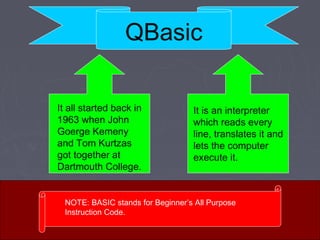




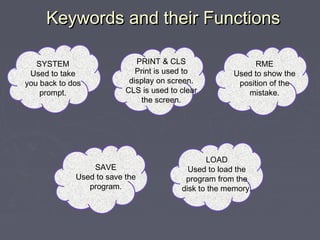
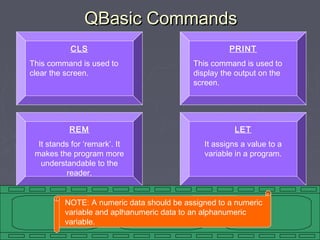
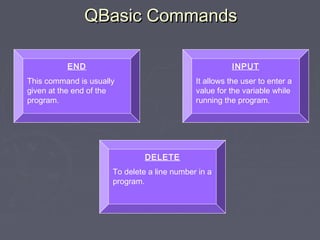
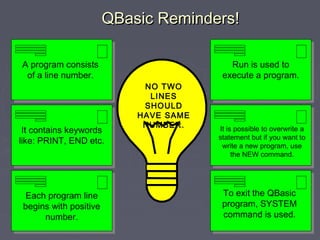


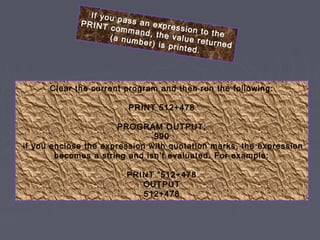
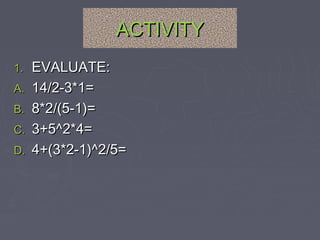


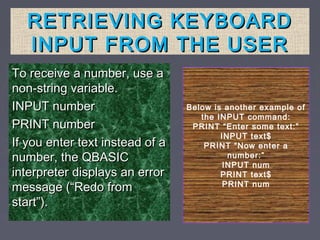









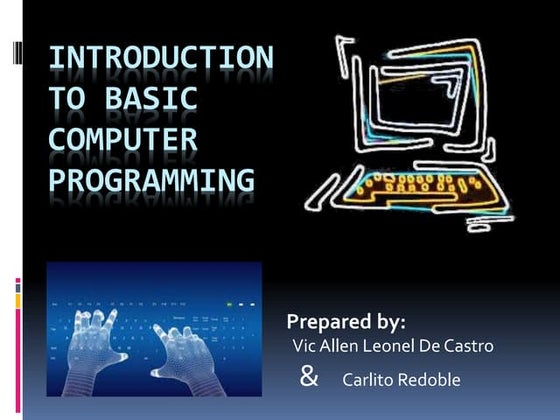

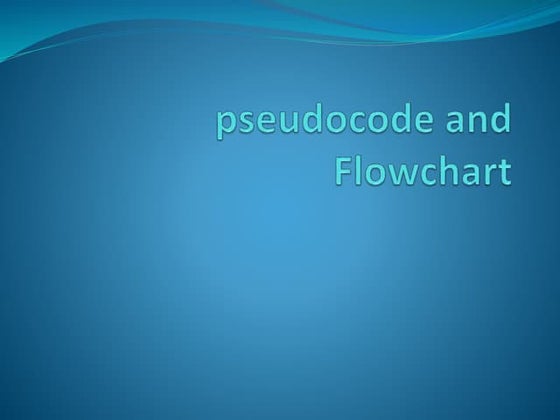
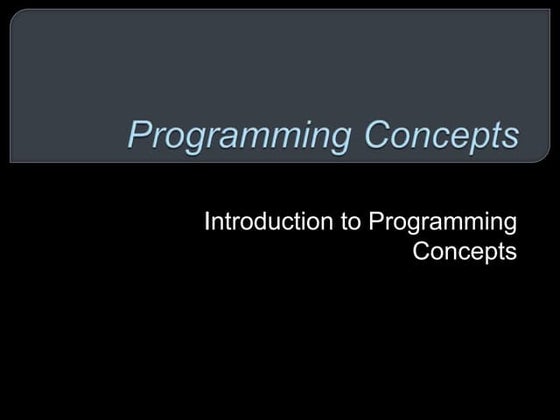





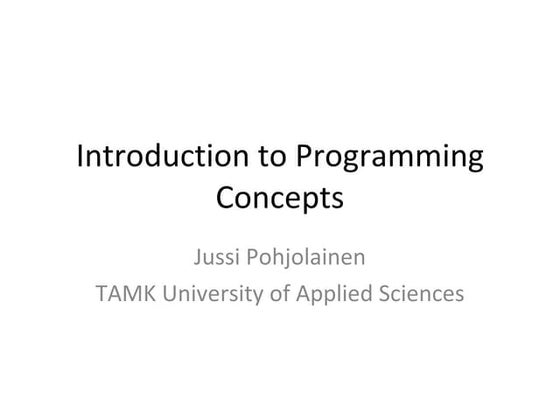

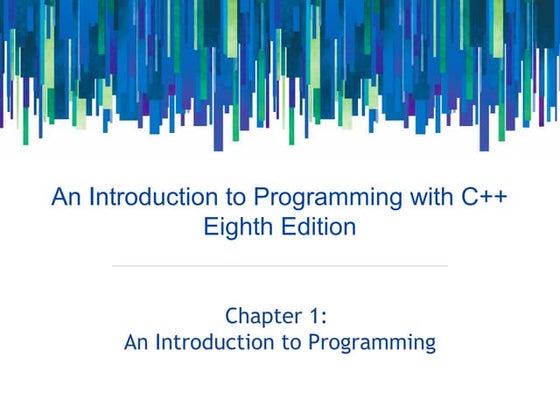



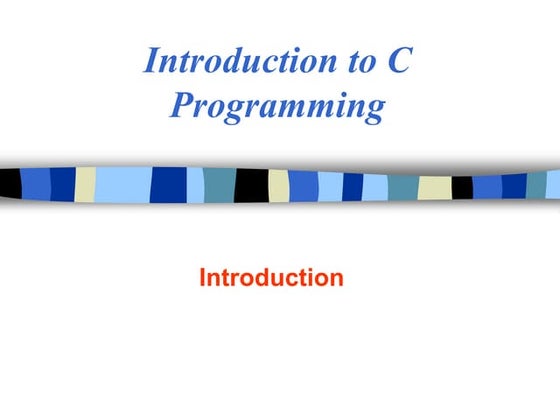
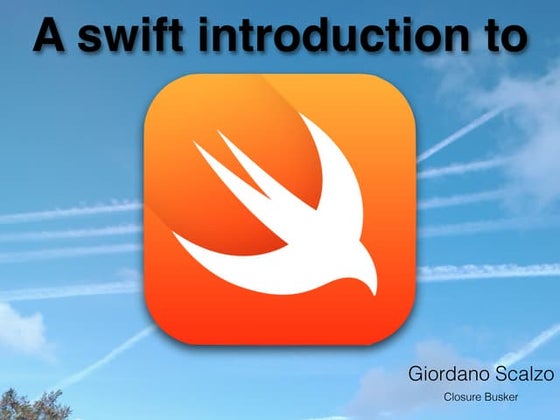



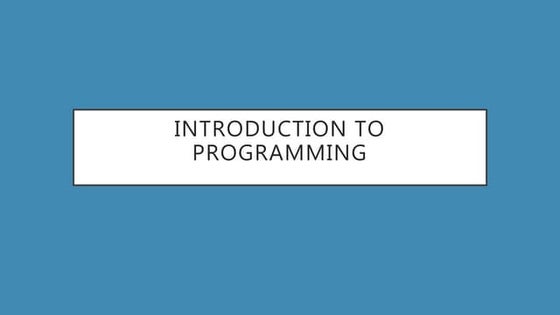

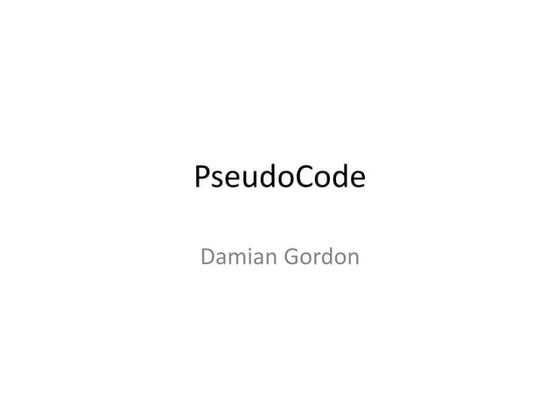

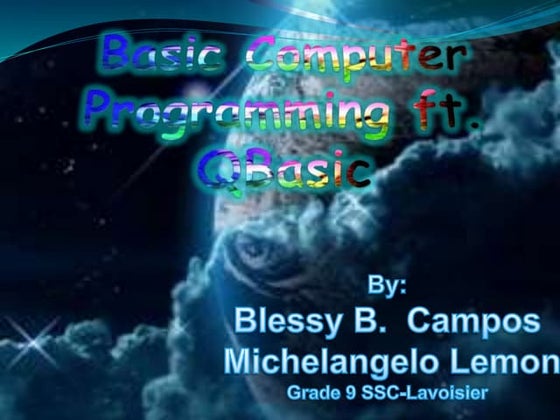





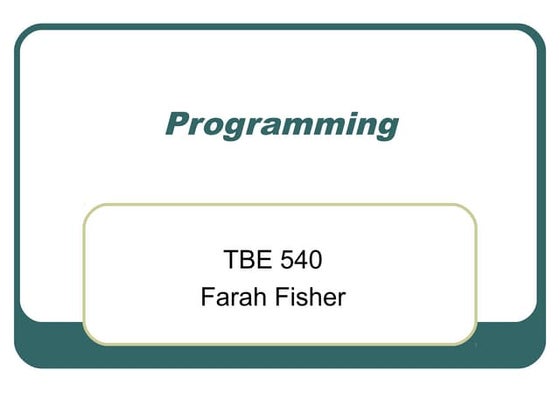




![Algorithm Design and Problem Solving [Autosaved].pptx](https://cdn.slidesharecdn.com/ss_thumbnails/algorithmdesignandproblemsolvingautosaved-230525024624-6a6fb3b2-thumbnail.jpg?width=560&fit=bounds)





